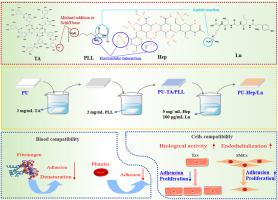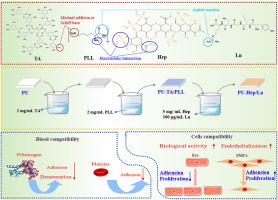Construction of an anticoagulant coating mimicking extracellular matrix for better surface blood compatibility and endothelialization of polyurethanes
IF 4.5
2区 化学
Q2 POLYMER SCIENCE
引用次数: 0
Abstract
Polyurethane (PU) is widely used in cardiovascular implant devices. However, the surface hydrophilicity and bioactivity of polyurethanes are relatively insufficient, which can easily lead to non-specific protein adsorption, thrombosis, intimal hyperplasia, and endothelial dysfunction after implantation, thereby limiting their further clinical application. To address these constraints, the tannic acid/polylysine was first constructed on the polyurethane substrate to improve surface hydrophilicity while introducing surface amino groups. Then, heparin/laminin anticoagulant coating mimicking extracellular matrix (ECM) was further prepared through electrostatic adsorption and amide reaction. The modified coating significantly improved the wetting property of the PU surface, selectively promoted the adsorption of albumin while inhibiting the absorption of fibrinogen, and prevented platelet adhesion and activation, resulting in a notable boost in anticoagulant functionality. In addition, the bionic coating significantly enhanced endothelial cell (EC) adhesion, proliferation, and functional expression while effectively suppressing these processes in smooth muscle cells (SMCs), demonstrating its potential for promoting endothelial regeneration. The ECM-inspired coating developed in this study provides a novel solution for endowing blood-contacting polyurethanes with both endothelial regeneration and anticoagulant properties.


构建一种模拟细胞外基质的抗凝涂层,以获得更好的表面血液相容性和聚氨酯的内皮化
聚氨酯(PU)广泛应用于心血管植入装置中。然而聚氨酯的表面亲水性和生物活性相对不足,植入后容易导致非特异性蛋白吸附、血栓形成、内膜增生、内皮功能障碍等,限制了其进一步的临床应用。为了解决这些限制,首先在聚氨酯衬底上构建单宁酸/聚赖氨酸,通过引入表面氨基来提高表面亲水性。然后通过静电吸附和酰胺反应制备模拟细胞外基质(ECM)的肝素/层粘胶蛋白抗凝涂层。改性后的涂层显著提高了PU表面的润湿性能,选择性地促进了白蛋白的吸附,同时抑制了纤维蛋白原的吸收,阻止了血小板的粘附和活化,抗凝功能显著增强。此外,仿生涂层显著增强内皮细胞(EC)的粘附、增殖和功能表达,同时有效抑制平滑肌细胞(SMCs)的这些过程,表明其促进内皮细胞再生的潜力。本研究开发的ecm启发涂层为赋予血液接触聚氨酯内皮细胞再生和抗凝血特性提供了一种新的解决方案。
本文章由计算机程序翻译,如有差异,请以英文原文为准。
求助全文
约1分钟内获得全文
求助全文
来源期刊

Polymer
化学-高分子科学
CiteScore
7.90
自引率
8.70%
发文量
959
审稿时长
32 days
期刊介绍:
Polymer is an interdisciplinary journal dedicated to publishing innovative and significant advances in Polymer Physics, Chemistry and Technology. We welcome submissions on polymer hybrids, nanocomposites, characterisation and self-assembly. Polymer also publishes work on the technological application of polymers in energy and optoelectronics.
The main scope is covered but not limited to the following core areas:
Polymer Materials
Nanocomposites and hybrid nanomaterials
Polymer blends, films, fibres, networks and porous materials
Physical Characterization
Characterisation, modelling and simulation* of molecular and materials properties in bulk, solution, and thin films
Polymer Engineering
Advanced multiscale processing methods
Polymer Synthesis, Modification and Self-assembly
Including designer polymer architectures, mechanisms and kinetics, and supramolecular polymerization
Technological Applications
Polymers for energy generation and storage
Polymer membranes for separation technology
Polymers for opto- and microelectronics.
 求助内容:
求助内容: 应助结果提醒方式:
应助结果提醒方式:


